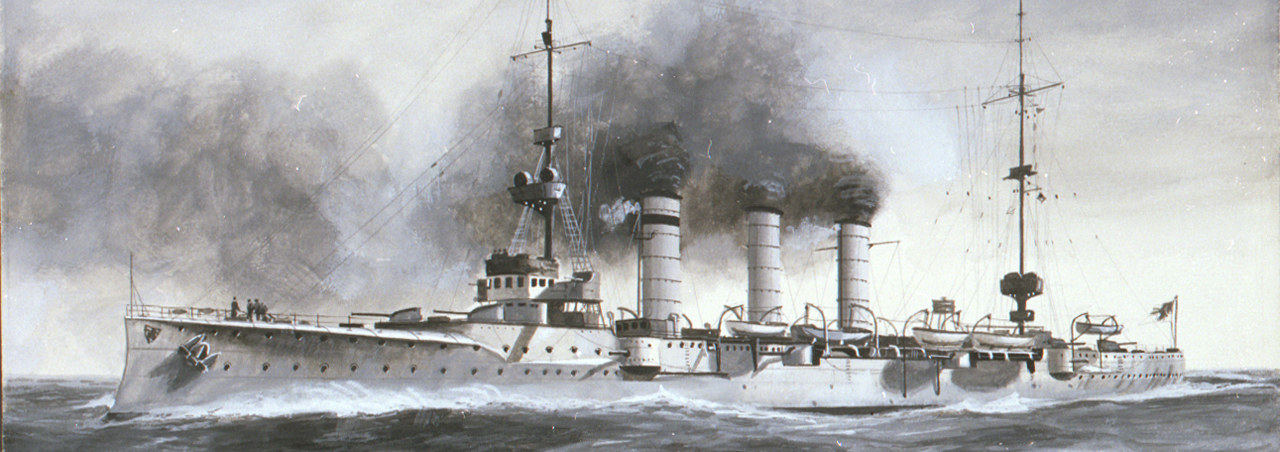
 Germany (1907-1927): SMS Kolberg, Mainz, Cöln, Augsburg
Germany (1907-1927): SMS Kolberg, Mainz, Cöln, AugsburgWW1 German Cruisers
Irene class | SMS Gefion | SMS Hela | SMS Kaiserin Augusta | Victoria Louise class | Prinz Adalbert class | SMS Prinz Heinrich | SMS Fürst Bismarck | Roon class | Scharnhorst class | SMS BlücherBussard class | Gazelle class | Bremen class | Kolberg class | Königsberg class | Nautilus class | Magdeburg class | Dresden class | Graudenz class | Karlsruhe class | Pillau class | Wiesbaden class | Karlsruhe class | Brummer class | Königsberg ii class | Cöln class
The Kolberg class is a class of light cruisers built for the Kaiserliche Marine shortly before the early 1910s. Four ships, SMS Kolberg, Mainz, Cöln, and Augsburg, were designed by the shipyards Schichau-Werke, AG Vulcan, Germaniawerft and Kaiserliche Werft from the cities of Danzig, Stettin and Kiel.
Design
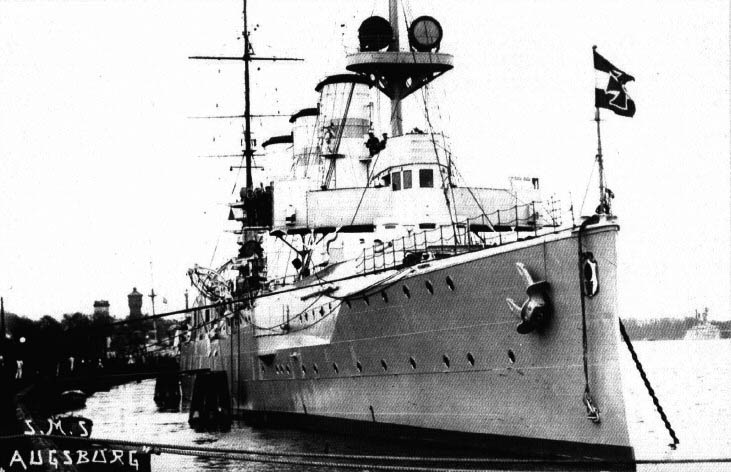
SMS Augsburg Dreblow
Development
Hull construction
The ships had a waterline length of 130 meters and an overall length of 130.50 meters, a beam of 14 meters and a draft of 5.45 meters at the bow and 5.73 meters at the stern. They displaced 4,362 tons at nominal load and 4,882 to 4,915 tons at full load.
Their hulls were constructed with longitudinal steel frames. The hulls have been divided into thirteen watertight compartments and incorporate a double bottom, extending 50% of the length of the keel. Considered excellent cruisers holding the sea well, they had a large turning radius. Steering was controlled by a single rudder. Their transverse metacentric height was 0.83 m.
The crew consisted of 18 officers and 349 crewmen. They embarked on several smaller vessels, including a picket ship, a barge, a cutter, two yawls and two dinghy.
Armour
Their shielding was made of Krupp-type steel. From stern to bow, the deck was covered with armor plate. This was 20 mm (0.79 in) at the bow, 40 mm (1.6 in) thick above the machinery spaces, 20 mm forward of the machinery spaces and 80 mm (3.1 inches) at the bow. The funnel coamings were 100 mm (3.9 in) thick. The castle had 100mm thick sides and a 20mm thick roof. The armor of the stores was 40 mm thick and the turrets protected by shields 50 mm thick (2 inches).
Powerplant
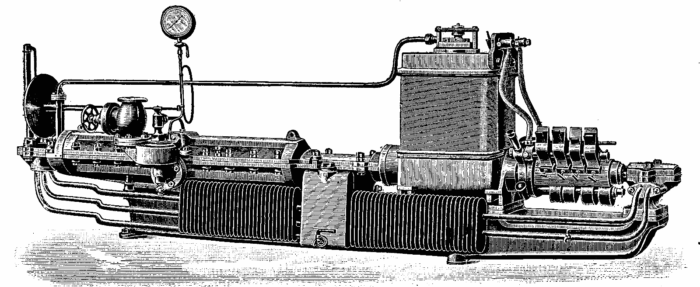
Parsons turbines set
The four ships had slightly different propulsion systems to test the best ones for future builds. The Kolberg was fitted with two sets of Melms & Pfenniger steam turbines, driving four three-bladed propellers 2.25 m in diameter. The Mainz was fitted with two sets of AEG-Curtiss turbines, driving a pair of three-bladed propellers 3.45 m in diameter. The Cöln was initially fitted with Zoelly turbines, before being replaced shortly before the start of her sea trials by a set of Germania turbines, driving four three-bladed propellers; two with a diameter of 2.55 m and two others of 1.78 m. The Augsburg was fitted with two groups of Parsons turbines, driving four 3-blade propellers 2.25 m in diameter. All four ships were fitted with fifteen coal-fired Marine-type water-tube boilers, divided into four boiler rooms on the centreline. The boilers were distributed in three chimneys, themselves distributed in a uniform way. In 1916 the Kolbergs and Augsburgs were fitted with an oil-fired heating system to increase the burn rate of the coal-fired boilers2, the Mainz and Cöln having been sunk at this time3.
Engine power was 19,000 horsepower (14,000 kW), except for those in the Mainz, rated at 20,200 hp (15,100 kW). This produced a top speed of 25.5 knots (47.2 km/h), Mainz’s more powerful engines gave her a half knot speed advantage. All four ships exceeded these figures in speed trials, however, and all four cruisers reached speeds in excess of 26 knots. The Kolberg carried 970 tons of coal and, after 1916, an additional 115 tons of fuel oil. This fuel gave it a maximum range of around 6,250 km at 14 knots (26 km/h). The Mainz carried 1,010 tons of coal, giving it a maximum range of around 6,720 km at cruising speed. The Cöln carried 960 tons of coal for a cruising radius of 6,500 km. The Augsburg carried 940 tons of coal and had the same range as the Cöln2.
Armament

Their main armament consisted of 12 single guns of 105 mm SK L/45 mounted on a base; two were placed side by side forward on the forecastle, eight amidships (four on each side), and two in superimposed turrets aft3. These guns fired a 17 kg shell at a muzzle velocity of 710 meters per second4. Their rates were 15 shells/min. The guns had a maximum elevation of 30 degrees, which allowed them to engage targets up to 12,700 meters4. For the Kolberg and Augsburg, the 105 cm guns were replaced in 1916-1917 by 6 x 150 mm SK L/45 guns. The 150 mm guns fired a 45 kg shell at a muzzle velocity of 835 meters per second. Their rates were 4.5 shells/min. The guns had a maximum elevation of 27 degrees, which allowed them to engage targets up to 16,800 meters4. Initially, their secondary armament consisted of 4 x 5.2 cm SK L/55 guns, quickly replaced in 1918 by 2 x 88 mm SK L/45 anti-aircraft guns. These guns fired 10 kg shells at a muzzle velocity of 765 m/s, for a rate of 15 shells/min. Their range was 11,800 meters at 45 degrees. The ships also included 2 x 450 mm (17.7 in) torpedo tubes (submerged in the keel), carrying 450 mm C/034 torpedoes. With a load of 176 kg, their range was 1,500 meters at 31 knots (57.4 km/h) and 3,000 meters at 26 knots (48.2 km/h)4. In 1918 Kolberg and Augsburg were fitted with two additional 500 mm (19.7 in) torpedo tubes, mounted on the deck. Carrying 500 mm G7 torpedoes, their load was 195 kg, their range was 4,000 meters at 37 knots (68.5 km/h) and 9,300 meters at 27 knots (50 km/h)4. Ships of the class carried on board up to 100 marine mines.
Construction
Ordered under the contract name “Ersatz Greif”, the Kolberg was laid down on January 15, 1908 at the Schichau-Werke shipyard in Danzig, under the hull number 814. She was launched on November 14, 1908 and then commissioned in the Hochseeflotte on June 21, 1910. Its construction will have cost 8,181,000 marks. The cruiser was in drydock at the Kaiserliche Werft yard in Kiel between 1916 and 1917.
Ordered under the contract name “Ersatz Jagd”, the Mainz was laid down in September 1907 at the AG Vulcan shipyard in Stettin, under the hull number 288. It was launched on January 23, 1909 and then commissioned in the Hochseeflotte October 1, 19096. Its construction will have cost 8,777,000 marks.
Ordered under the contract name “Ersatz Schwalbe”, the Cöln was laid down in 1908 at the Germaniawerft shipyard in Kiel, under the hull number 191. She was launched on June 5, 1909 and then commissioned into the Hochseeflotte on June 16 June 1911. Its construction cost 8,356,000 marks.
Ordered under the contract name “Ersatz Sperber”, the Augsburg was laid down in 1908 at the Kaiserliche Werft shipyard in Kiel, under the hull number 34. She was launched on July 10, 1909 and then commissioned into the Hochseeflotte October 1, 1910. Its construction will have cost 7,593,000 marks. The cruiser was in drydock at the Kaiserliche Werft shipyard in Kiel between 1916 and 1917.
⚙ Kolberg class specifications |
|
| Dimensions | 130.5 x 14 x 5.45/57.3 m (428 x 45 x 17 ft) |
| Displacement | 4,362 tons standard, 4,882/4,915 tons Fully Loaded |
| Crew | 18 Officers, 349 sailors peacetime |
| Propulsion | 2 shafts turbines, 15 boilers, 20,200 hp (15,100 kw). |
| Speed | 25.5 knots (47.2 km/h) |
| Range | 6,250-6,720 nm @ 10 knots. |
| Armament | 12× 10,5 cm, 4x 5,2 cm, 2x 45 cm TTs |
| Protection | Deck 20–40 mm, Gun shields 50 mm, CT 100 mm (3.9 in) |
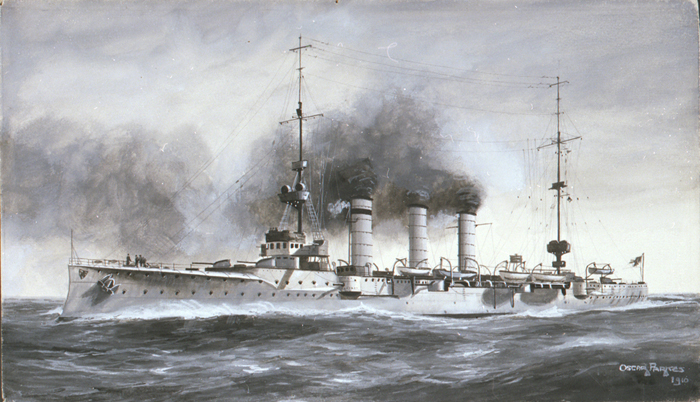
German_scout_Mainz_RMG
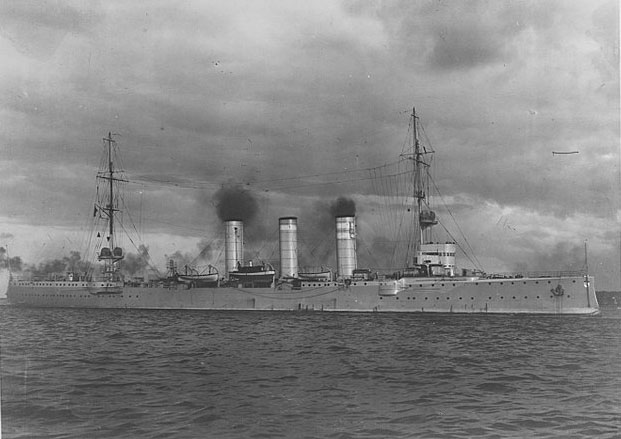
SMS Mainz
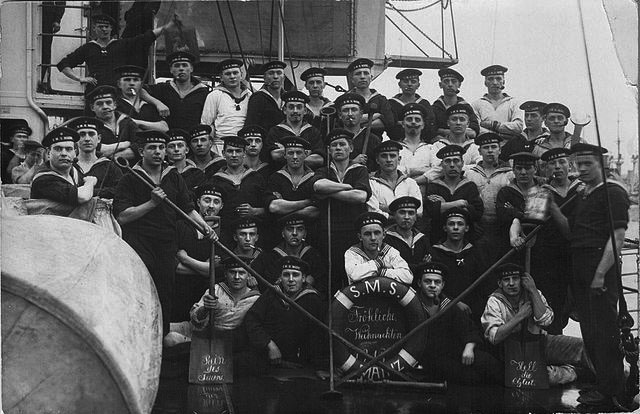
SMS Mainz’s crew
Prewar and WWI career
 SMS Kolberg
SMS Kolberg

S.M.S. Kolberg Postcard
The Kolberg witnessed several face-to-face encounters with the British during the war, including the raid on Scarborough, Hartlepool and Whitby in December 1914 and the Battle of Dogger Bank the following month. It also faced the Russians twice9, during the Battle of the Gulf of Riga in August 1915 and during Operation Albion in November 191710. After the end of the war, it was ceded to France as a war prize and renamed Colmar . She served briefly in the French Navy, including a deployment to Asia in 192411. The Colmar was withdrawn from service in 1927 and scrapped two years later.
 SMS Mainz
SMS Mainz
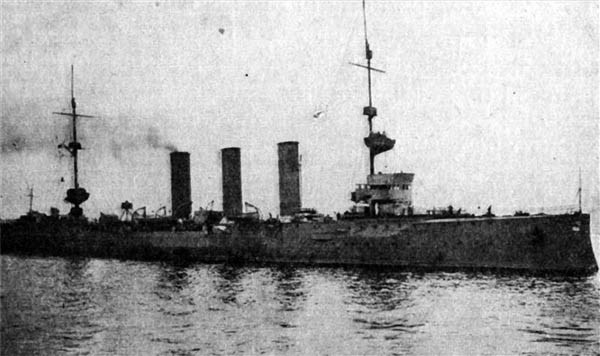
After commissioning, Mainz served with the II Scouting Group, part of the reconnaissance forces of the Hochseeflotte13. She was assigned to patrols off Heligoland Bay at the outbreak of World War I in early August 191414. In late August 1914 she fought in the First Battle of Heligoland in which she was sunk by British cruisers and destroyers on the morning of 28 August15.16. The British rescued 348 crew before the ship rolled over and sank. Eighty-nine men were killed in the battle, including its commander.
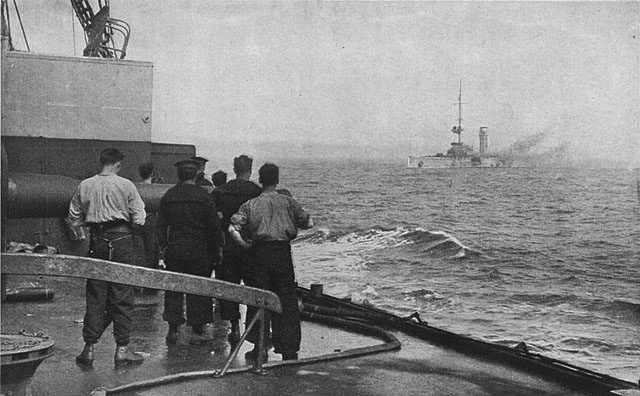
Camera Record Mainz off Heligoland, August 28th, 1914
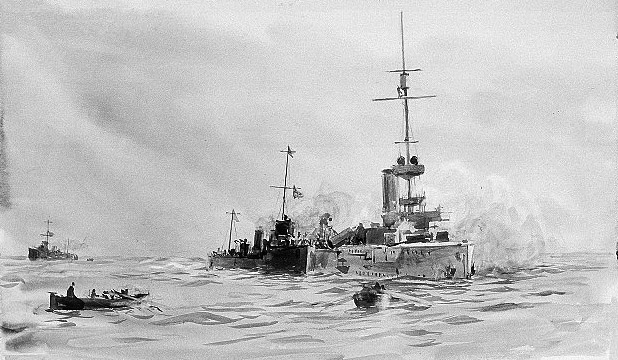
Rescuing Mainz’s crew after the battle of Heligoland Bight, 28 August 1914
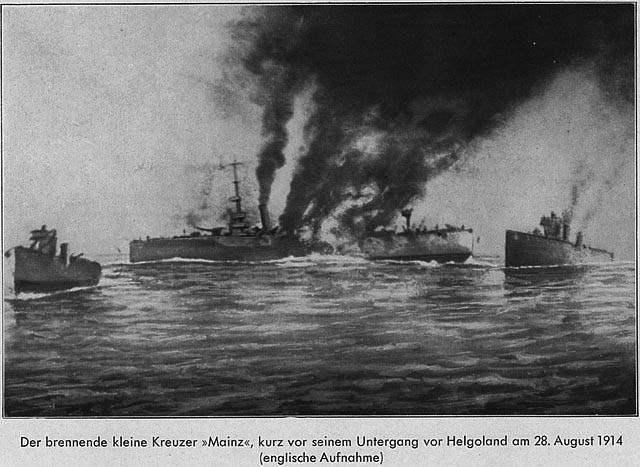
The burning cruiser Mainz just before sinking before Helgoland
 SMS Cöln
SMS Cöln

After commissioning, Cöln served with the II Scouting Group, part of the reconnaissance forces of the Hochseeflotte. She was assigned to patrols off Heligoland Bay at the outbreak of World War I in early August 1914. In late August 1914 she fought in the First Battle of Heligoland in which she was sunk by British cruisers and destroyers on the morning of 28 August. The crew abandoned ship, but German forces did not search the area for three days; only one man was found alive.
 SMS Augsburg
SMS Augsburg
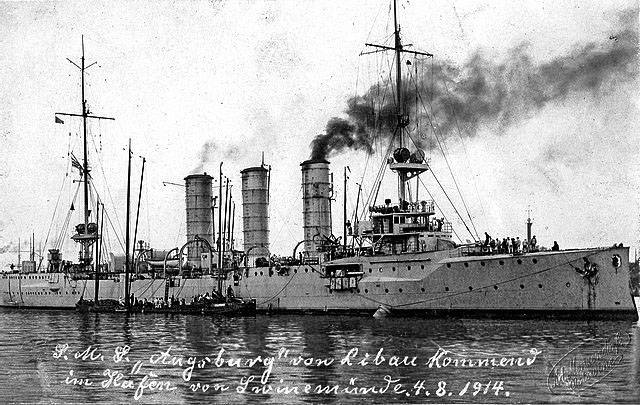
At the beginning of her career, SMS Augsburg acted as a torpedo test ship, then as a gunnery training ship. After the outbreak of the First World War, she was assigned to the Baltic Sea, where she spent the entire duration of her service. On August 2, 1914, she took part in an operation during which the first shots were fired against the Russians. She then took part in the Battle of the Gulf of Riga on 20 in August 1915, and Operation Albion in October 1917, as well as many smaller engagements. By January 1915, she hit a mine and was inoperative for many months. After the end of the war, she was ceded to Japan as spoils of war and renamed “Y”. She was was scrapped in 1921.

SMS Augsburg in Dreblow
Interwar career: FS Colmar, ex-Kolberg
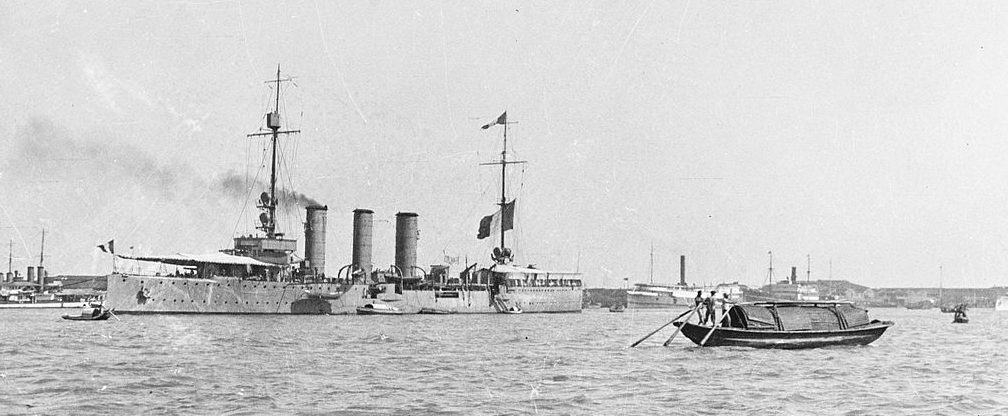
Colmar (ex-Kolberg) in Shanghai, 1924
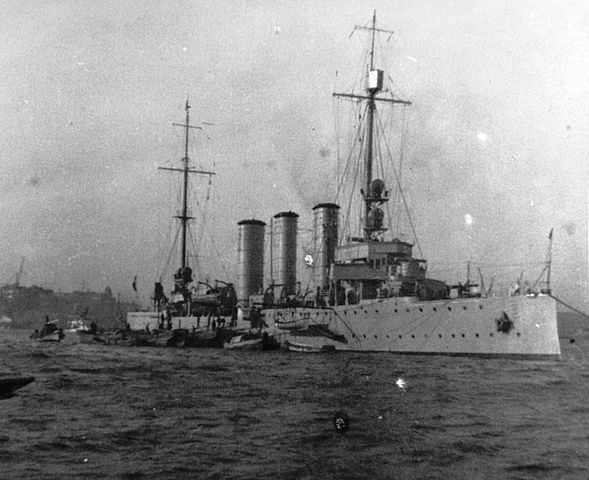
Colmar in Indochina 1925
SMS Kolberg was stricken on 5 November 1919 and handed to the French in Cherbourg on 28 April 1920 as “W”. She was recommissioned as Colmar in 1922, her original 8.8 cm guns replaced by 75 mm ones. A new aft deckhouse was built and an extra 75 mm gun installed on its roof.
Her sea trials lasted until late 1922, and she was sent for colonial service in French Indochina, departed in June and arriving on 7 September 1922. She replaced Montcalm as flagship of the Naval Division of the Far East and was sent in Vladivostok in 1923 after the Great Kantō earthquake, proceeding to Yokohama to assist in the relief effort with Jules Michelet, Victor Hugo, and Jules Ferry. In 1924, Colmar and Jules Ferry also landed troops to protect western interests during the violence in Shanghai. Colmar was back in France in February 1925 and lasted in service a few more months, until decommissioned in November. She was cannibalized until 1927, for the other ex-German cruisers until and stricken on 21 July 1927, sold for BU. See also about Colmar/Kolberg.


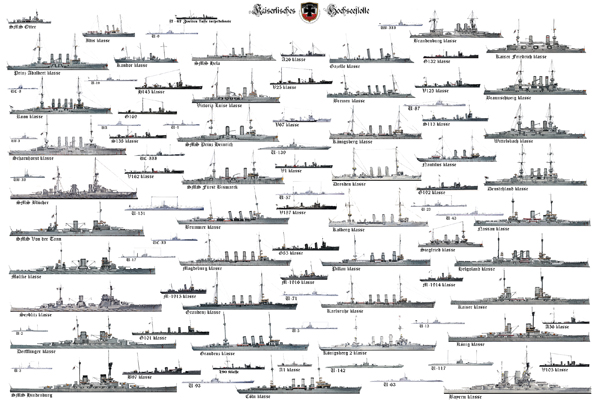
 Latest Facebook Entry -
Latest Facebook Entry -  X(Tweeter) Naval Encyclopedia's deck archive
X(Tweeter) Naval Encyclopedia's deck archive Instagram (@navalencyc)
Instagram (@navalencyc)





 French Navy
French Navy Royal Navy
Royal Navy Russian Navy
Russian Navy Armada Espanola
Armada Espanola Austrian Navy
Austrian Navy K.u.K. Kriegsmarine
K.u.K. Kriegsmarine Dansk Marine
Dansk Marine Nautiko Hellenon
Nautiko Hellenon Koninklije Marine 1870
Koninklije Marine 1870 Marinha do Brasil
Marinha do Brasil Osmanlı Donanması
Osmanlı Donanması Marina Do Peru
Marina Do Peru Marinha do Portugal
Marinha do Portugal Regia Marina 1870
Regia Marina 1870 Nihhon Kaigun 1870
Nihhon Kaigun 1870 Preußische Marine 1870
Preußische Marine 1870 Russkiy Flot 1870
Russkiy Flot 1870 Svenska marinen
Svenska marinen Søværnet
Søværnet Union Navy
Union Navy Confederate Navy
Confederate Navy Armada de Argentina
Armada de Argentina Imperial Chinese Navy
Imperial Chinese Navy Marinha do Portugal
Marinha do Portugal Mexico
Mexico Kaiserliche Marine
Kaiserliche Marine 1898 US Navy
1898 US Navy Sovietskiy Flot
Sovietskiy Flot Royal Canadian Navy
Royal Canadian Navy Royal Australian Navy
Royal Australian Navy RNZN Fleet
RNZN Fleet Chinese Navy 1937
Chinese Navy 1937 Kriegsmarine
Kriegsmarine Chilean Navy
Chilean Navy Danish Navy
Danish Navy Finnish Navy
Finnish Navy Hellenic Navy
Hellenic Navy Polish Navy
Polish Navy Romanian Navy
Romanian Navy Turkish Navy
Turkish Navy Royal Yugoslav Navy
Royal Yugoslav Navy Royal Thai Navy
Royal Thai Navy Minor Navies
Minor Navies Albania
Albania Austria
Austria Belgium
Belgium Columbia
Columbia Costa Rica
Costa Rica Cuba
Cuba Czechoslovakia
Czechoslovakia Dominican Republic
Dominican Republic Haiti
Haiti Hungary
Hungary Honduras
Honduras Estonia
Estonia Iceland
Iceland Eire
Eire Equador
Equador Iran
Iran Iraq
Iraq Latvia
Latvia Liberia
Liberia Lithuania
Lithuania Mandchukuo
Mandchukuo Morocco
Morocco Nicaragua
Nicaragua Persia
Persia San Salvador
San Salvador Sarawak
Sarawak Uruguay
Uruguay Venezuela
Venezuela Zanzibar
Zanzibar Warsaw Pact Navies
Warsaw Pact Navies Bulgaria
Bulgaria Hungary
Hungary

 Bundesmarine
Bundesmarine Dutch Navy
Dutch Navy Hellenic Navy
Hellenic Navy Marina Militare
Marina Militare Yugoslav Navy
Yugoslav Navy Chinese Navy
Chinese Navy Indian Navy
Indian Navy Indonesian Navy
Indonesian Navy JMSDF
JMSDF North Korean Navy
North Korean Navy Pakistani Navy
Pakistani Navy Philippines Navy
Philippines Navy ROKN
ROKN Rep. of Singapore Navy
Rep. of Singapore Navy Taiwanese Navy
Taiwanese Navy IDF Navy
IDF Navy Saudi Navy
Saudi Navy Royal New Zealand Navy
Royal New Zealand Navy Egyptian Navy
Egyptian Navy South African Navy
South African Navy






























 Ukrainian Navy
Ukrainian Navy dbodesign
dbodesign
The SMS Augsburg was recently found sunk off the coast of Matua. This is different from your information.
Can you point out your source please ?